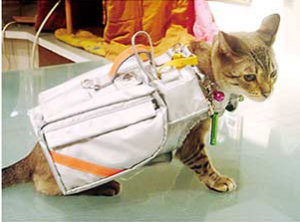By Dr. Beth Leermakers
Like thousands of other DFW residents, I lost power during the recent storm. After realizing that I had nothing to eat that didn’t require electricity, my concern shifted to my dogs’ safety and comfort. I worried about my senior dog, who is more vulnerable to the heat due to his age. Taking five big dogs to a dog-friendly hotel wasn’t an option, even if I could have fit them all in my SUV. Fortunately, cooler weather prevailed during our 20 power-less hours, so the temperature in my house remained bearable.
Now is a good time to develop a plan to keep your pets safe when disasters — fires, tornadoes, hurricanes or floods — strike. Hopefully it goes without saying that, if you need to evacuate due to a natural disaster, your pets need to go with you. If your house isn’t safe for you, it’s not safe for your pets. Please don’t leave them behind.
Preparation is the key to an effective emergency plan:
Locate your pet’s favorite hiding place. To leave with your cat, you have to be able to find your cat when he’s scared. The next time it storms, look for your pet’s hiding place. Some pets retreat under the bed or into a closet, but yours may have a different favorite safe spot. Put a bell on your pet’s collar so it’s easier to locate him.

Photo courtesy of Smart Dogs/Wordpress
Get your cat used to a cat carrier. When you’re hurrying to leave, you don’t need the added stress of forcing a terrified, flailing cat into a small carrier. Leave the carrier out in your cat’s favorite room so she can smell it. Place treats inside the carrier to entice her to enter on her own. Take her for a short car ride (not to the vet clinic) so she learns that road trips aren’t a bad thing. Introduce your dog to a crate if he’s not used to being in one. Treats and patience work wonders.
Identify your pets. Put ID tags on their collars and update the microchip contact information. I buy collars with my pets’ names and my phone number embroidered on them, since my dogs tend to lose their ID tags.
Plan your escape. Where will you go in two situations: a small, local disaster and a larger, regional calamity. If you don’t have friends or family in safe areas (who will welcome your fur kids), identify pet-friendly hotels. Check out these websites: hotels.petswelcome.com/, bringfido.com, and dogfriendly.com. I’ve had good luck staying at La Quinta, where there usually aren’t any pet deposits or pet fees. If you’ll be crossing state lines, you’ll need to take your pet’s medical and vaccination records with you. The free Pet First Aid app from the American Red Cross includes ideas on what to do in emergencies and helps you find pet-friendly hotels and emergency veterinarians.
Be sure you can fit all your animals in your car. Because my SUV isn’t big enough to accommodate five medium-to-large crates, I would need to rent a bigger vehicle or find someone to take a couple of my dogs.
Gather the necessary supplies for a quick departure. Store everything you’ll need in a duffel bag so you can grab it and go. Include these must-have items in your emergency kit:
A several-day supply of food and water for each pet
Food and water bowls (collapsible bowls are handy)
A manual can opener if the pet food cans don’t have pull tabs
Leashes and collars or harnesses for each pet (even for your cats)
A carrier/crate for each pet. Cats and dogs are safer when they’re contained in the car. Birds and small animals (hamsters, gerbils, reptiles) need a cage that’s large enough to be comfortable for a few days.
Litter box and cat litter
Poop bags
First aid kit (bandages, antibiotic ointment, hydrogen peroxide, etc.)
Current medical and vaccination records. Take pictures of your vet records and store them in the cloud so you can access them anywhere.
Medications to last at least two weeks
Names and phone numbers for: your veterinarian, emergency pet hospitals near home and where you are planning to stay, family and friends who can provide shelter for you and your pet if necessary, local pet boarding facilities, or pet-friendly hotels. Keep a paper copy in case your cell phone battery dies. Yes, you should also pack a car charger.
Your pet’s favorite bed or blanket and toys
An extra collar and leash (a sturdy slip leash that fits all sizes works well)
Towels, paper towels and garbage bags for cleanups
Planning ahead will help you evacuate more quickly, protecting you and your pets. Hopefully, you won’t ever need your emergency plan and supplies, but you’ll be ready if you do.
